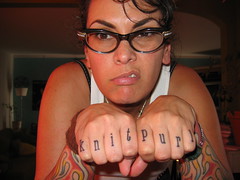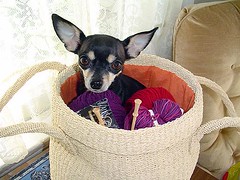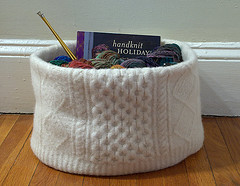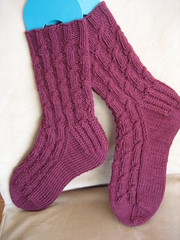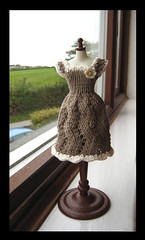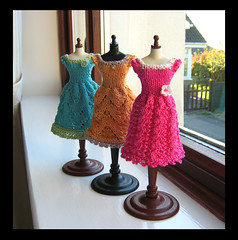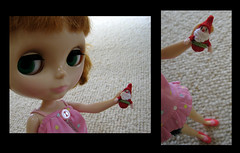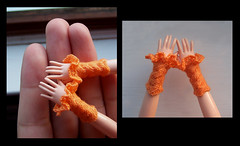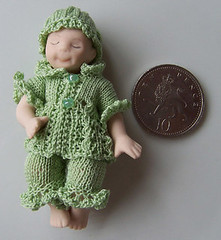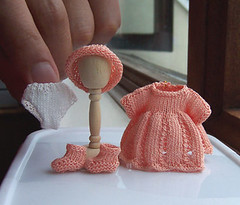Greetings~
I've been out for a week. Life has taken a slight turn, and shown me a new road I'm going to be traveling. My son was diagnosed with Type 1 diabetes Tuesday morning, and we spent 4 days at the Children's Hospital, getting him rehydrated and learning about this disease.
So, how does this relate to knitting? I looked up the words Knitting and Diabetes, and found this good article, written by Canadian knitter Ennien Ashbrook:
**Note--this isn't written by the Knit Chick, but something I found useful and wanted to share with you.
--
Socks for Diabetic Feet
We hear this question all the time -- "Why do you knit socks?" It's a question that instantly betrays the asker as a non-knitter. Any knitter knows we don't need a reason to knit anything! We know perfectly well that we can buy socks. We just like to knit.
With diabetes on the rise, we find ourselves with another reason to knit socks. Most every new diabetic comes out of the clinic looking baffled by all the emphasis on their feet and particularly puzzled by the admonition to toss their cotton tube socks and wear special socks. Special socks are our specialty! But in order to knit the best socks, we must first understand two things: 1) The diabetic foot, and 2) the effects of different fibres on the diabetic foot.
Diabetic feet are usually cold, don't sweat as much as normal feet, heal slowly, infect easily, and aren't as sensitive to touch or pain. The effects may be more or less, depending on the progress of the disease. The root cause of nearly all of these effects is diabetes' destruction of nerves and blood circulation. Loss of blood circulation is the cause of nearly all of diabetes' end effects, from sepsis and amputation to heart attack and stroke.
The decrease of blood circulation to the feet means that not enough white corpuscles are brought to injured areas; thus the risk of infection is substantially increased for the diabetic. Healing is also slower, again because of the impaired blood supply.
Like the palms of the hands, the soles of the feet do not have sebaceous glands and rely on perspiration to maintain their suppleness. The cold feet of diabetics don't sweat as easily or as much as normal feet, so the skin may dry out and be prone to cracking. Cracks allow bacteria to enter the body, leading to possible infections.
Diabetes also damages the nerves and decreases sensitivity. This means that diabetics quite often don't feel small wounds and abrasions on their feet that people with normal feet would feel right away. Small wounds go unnoticed and untreated, heal slowly, and thus provide fertile ground for bacteria. Because of this, diabetics are usually advised to examine their feet daily, treat and bandage small wounds even if they aren't painful, and moisturize their feet. They're also cautioned to wear socks and shoes that are properly fitted and don't rub or abrade the feet.
Now we're into our territory: The socks! Now that we understand the characteristics of the feet we're knitting for, we need to understand what makes a sock good or bad for diabetes, plus we need to understand how different fibre contents affect diabetic feet. Diabetes journals and diabetes educators offer a lot of conflicting advice about this topic, because, quite frankly, there hadn't been much research into socks. That's changed now and there are several studies that we can learn from. Alas, the studies only investigated commercial socks, but we can use their results to improve our handknitting.
For diabetic feet, a "good sock" is defined as one that fits snugly without impairing circulation, that stays in place and doesn't bunch or twist in the shoe, which keeps the foot comfortably warm and dry, and which doesn't cause abrasions. The heel is particularly vulnerable because it's the most insensitive (even in a normal foot), it's exposed to considerable abrasion from shoes and impact, and it's difficult to inspect by oneself. Tube socks tend to bunch at the instep and stretch over the heel, reducing cushioning of this vulnerable spot. They frequently twist around during wearing and the seams may abrade the toes. Shaped, fitted socks are preferable to tube socks because they stay in place better and provide more uniform cushioning over the foot.
Natural fibers are best, right? Surprisingly, Doctors Kirk M. Herring and Douglas H. Richie found that this wasn't necessarily the case. These researchers ranked sock fibers in terms of moisture wicking, moisture retention, shape retention, and abrasiveness. Their findings were quite surprising: The best fibers were Coolmax and acrylic, while the absolute worst was cotton! Cotton absorbs moisture, but then hangs onto it like a towel, keeping the moisture against the skin instead of wicking it away (which is why cotton socks start to feel slimy after wearing for a while.) This can lead to chapping. Cotton socks were found to get more abrasive with continued wash-wear cycles, leading to blisters and abrasion rashes. Lastly, cotton socks were found to stretch and lose their shape with wearing, causing them to shift and bunch in the shoe. These effects were not mitigated by blending with other fibers.
Wool fared better than cotton. Wool absorbs some moisture, but also wicks it away from the skin. However, wool will compress during wearing and reduce its wicking ability. Although wool is still more abrasive than synthetics, superwash merinos are less abrasive than untreated wools and overall wool was found to be less abrasive than cotton. The abrasive qualities of wool were found to be mitigated by blending with synthetics, which also enhanced wool's wicking qualities. There are still many good reasons to dress diabetic feet in wool or a wool blend, though: Wool is the only fiber, natural or synthetic, that retains its thermal qualities when wet. That's particularly important for people who work outdoors or in cold climates. Being a natural fiber, wool breathes and deters fungal growth like athlete's foot. As knitting fingers know, wool is more elastic than cotton and retains its shape better, so wool socks are less prone to bunching and twisting.
Acrylic fared well. It has decent wicking qualities, doesn't compress, doesn't lose its shape, and is less abrasive than cotton or wool. Comparing cotton socks to acrylic socks, the acrylic socks were found to cause fewer blisters.
What does this mean for us handknitters? I haven't found any Coolmax yarns yet and a search of the Coolmax site reveals no such thing. It does mean that we should probably pass over any sock yarn with cotton when knitting for a diabetic. Instead, we should look for baby acrylics and soft wool blends with a higher percentage of synthetic. The best wool blend would include some acrylic or polypropylene along with soft superwash merino, perhaps with some nylon or polyamide for strength, such as Lang's "Jawoll Superwash" sock yarn. Otherwise, a traditional wool/nylon sock yarn will be good, especially if the percentage of nylon is a little higher, such as Regia's 75/25 blend. Some wool blends are treated, such as Austerman's "Step", which is a wool/nylon blend treated with aloe vera and jojoba oil. These help soften the feet and reduce abrasion.
Another yarn to consider is Knit One Crochet Too's "Wick." This is a blend of soy protein fibre and polypropylene. Polypropylene has been shown to have excellent wicking properties and elasticity; it has long been used in mesh thermal underwear for sports. Although to my knowledge, soy protein fibre has not been investigated specifically as a sock, its smooth fibre staple, strength, wicking and anti-bacterial properties make it promising, especially for vegan diabetics. "Wick's" downside is that it is currently available only as a worsted-weight yarn. It makes a bit thicker of a sock and the purl-side bumps could prove irritating to the feet. To combat this, knit the sock in reverse stockinette, or wear a liner sock.
Encourage the diabetic to give feedback on your handknit socksand to continue doing so. This is very important: Diabetes has a tendency to "jump" in severity every five years or so, so socks that were giving no trouble one year may give rashing or blisters the year after. Diabetes may progress slowly or quickly, but it never stops.
With our awareness of abrasion, should we choose a traditional heel-stitch heel? This will depend on the individual's needs and feet. My diabetic husband wears steel-toed safety boots at work and these are quite hard on the heels. Socks with a short-row heel seem to wear down quickly, so I knit his socks with a heel-stitch heel flap for the extra cushioning it provides, bearing in mind the roughness of the inner surface. (So far so good, he hasn't shown any signs of irritation.) If a heel-stitch heel proves to be irritating, the knitter can choose another sort, such as short-row or peasant heels. We're lucky that way!
Knitters are lucky another way as well: We can shape the sock to fit the foot exactly, even if part of the foot is missing. No joke - my diabetic brother-in-law just lost two toes due to septic infection of the foot. After amputation, the need for protective socks is even more urgent. Commercial socks can't deliver a perfect fit, but we can.
Because of abrasion, we might want to think twice about using those lovely lacy or pebbled pattern stitches for a diabetic's sock and stick with simple stockinette and ribbing. Again, get feedback: Some will have no problems, while others will show irritated skin or rashing. If the sock bags a little at the heel or ankle, it's too loose and will abrade; if the stitches look stretched when on the foot, it's too tight and may hamper circulation at the skin surface. The sock must fit like a glove, without stretched-looking stitches. If your favorite sock pattern doesn't fit quite perfectly, adjust it. Or, as I do, use a formula based on measurements and gauge that gives a perfect fit every time. If you're knitting a pattern and wish to keep it intact on the instep, do your adjusting on the sole stitches.
If the foot has lost much of its feeling, or if it has already suffered serious injury, such as septic wounds or amputation, it's best to take no chances with abrasion - these are high-risk feet. According to Dr. Richie, a study done by the United States military discovered that wearing a CoolMax or polypropylene liner sock beneath the outer sock will reduce abrasions considerably. The friction of the shoe is dispersed between the outer sock and inner sock, instead of a single sock and the skin. CoolMax and polypropylene have been found to have excellent wicking qualities, so moisture is transported away from the skin and into the outer sock. For the high-risk foot, the best combination would be a thin CoolMax or polypropylene liner sock, under a wool sock. The wool will retain what little heat the high-risk foot creates, and will wick away moisture, while the liner protects the skin.
A diabetes diagnosis can be scary: Strokes, organ failure, infection, and amputation are potential threats if blood sugar levels are not properly maintained, while a restricted diet and daily poking are immediate, permanent changes. A handknit sock is a gesture of love; a knitter who does research, gets feedback, and knits the best possible sock is saying "I'm with you all the way." Why knit socks? It's not because we can -- it's because we care.
References:
"Socks and Your Feet," Douglas H. Richie Jr
"Sockwear Recommendations for People with Diabetes," Carol B. Feldman & Ellen D. Davis
"Sweaty Socks," Jennifer Faddis, University of Missouri-Columbia
Peer-reviewed, published research portal, with links to PDFs, Institute for Preventative Foot Health
"Properties of Soybean Fibre," SwicoFil AG Textile Services, Switzerland
|
Ennien Ashbrook is a power engineer by day, dancer by night. In between, she finds time for knitting, tatting and volunteering on a running steam locomotive.
She lives with her husband and her cat, north of Calgary, Alberta.
| | Text © 2007 Ennien Ashbrook. |
|
___________________
I found this article at the Knitty: Little Purls of Wisdom page
http://www.knitty.com/issuesummer07/FEATdiabeticfeet.html
Warmly yours,
--The Knit Chick












 According to
According to 